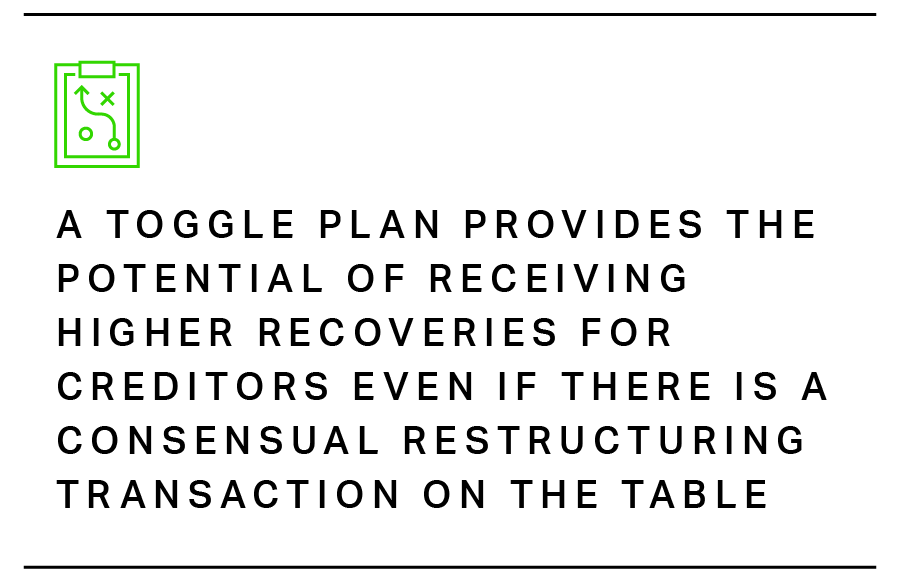
In proposing a plan of reorganization in a Chapter 11 case, the debtor’s goal is to first and foremost maximize the value of the estates for its stakeholders, including its creditors. While it is common for a debtor to commence a case with a proposed single path of exit from the cases – whether by asset sale, recapitalization, or otherwise – debtors in recent years have increasingly turned to another plan construct that embodies a new value-maximizing strategy: the toggle plan.
In a Chapter 11 proceeding, the debtor must file a plan of reorganization that delineates its chosen path for emergence from bankruptcy and meets the statutory requirements for confirmation under the Bankruptcy Code – be it a recapitalization through new money, a debt-for-equity exchange, a sale, or an orderly wind-down. Recently, courts overseeing Chapter 11 cases are witnessing an increasing number of “toggle” plans, which present two or more alternative paths to emergence from bankruptcy.



In proposing a plan of reorganization in a Chapter 11 case, the debtor’s goal is to first and foremost maximize the value of the estates for its stakeholders, including its creditors. While it is common for a debtor to commence a case with a proposed single path of exit from the cases – whether by asset sale, recapitalization, or otherwise – debtors in recent years have increasingly turned to another plan construct that embodies a new value-maximizing strategy: the toggle plan.
In a Chapter 11 proceeding, the debtor must file a plan of reorganization that delineates its chosen path for emergence from bankruptcy and meets the statutory requirements for confirmation under the Bankruptcy Code – be it a recapitalization through new money, a debt-for-equity exchange, a sale, or an orderly wind-down. Recently, courts overseeing Chapter 11 cases are witnessing an increasing number of “toggle” plans, which present two or more alternative paths to emergence from bankruptcy.


As discussed further below, in providing debtors with additional flexibility, under the right circumstances toggle plans can streamline the Chapter 11 process, minimize costs, and increase the chances of a successful exit from bankruptcy. While any viable plan transaction could serve as a toggle alternative under a toggle plan, the most common structure is for the debtor to file a Chapter 11 plan that toggles between a 363 sale and a reorganization i.e., the debtor would conduct a 363 sale process at the outset of the Chapter 11 case, and if there is no successful buyer that proposes a higher value transaction, the debtor would pivot to a reorganization transaction contemplated by and set forth in the Chapter 11 plan.
Another common structure is a toggle between a 363 sale and a wind down. By embedding the toggle structure into the plan, the debtor can file its Chapter 11 plan at the start of the case and commence the plan process while the debtor’s business is marketed to potential buyers in parallel.


As discussed further below, in providing debtors with additional flexibility, under the right circumstances toggle plans can streamline the Chapter 11 process, minimize costs, and increase the chances of a successful exit from bankruptcy. While any viable plan transaction could serve as a toggle alternative under a toggle plan, the most common structure is for the debtor to file a Chapter 11 plan that toggles between a 363 sale and a reorganization i.e., the debtor would conduct a 363 sale process at the outset of the Chapter 11 case, and if there is no successful buyer that proposes a higher value transaction, the debtor would pivot to a reorganization transaction contemplated by and set forth in the Chapter 11 plan.

Another common structure is a toggle between a 363 sale and a wind down. By embedding the toggle structure into the plan, the debtor can file its Chapter 11 plan at the start of the case and commence the plan process while the debtor’s business is marketed to potential buyers in parallel.

Toggle Plans: Examples and Outcomes
A survey of some recently filed toggle plans, filed in bankruptcy courts across the U.S., illustrate these structures and potential outcomes. Of these, most have been confirmed, one is pending confirmation, and one was set aside for a proposed alternative. Though most plans contemplated a sale option, most of the debtors did not toggle to a sale due to the lack of qualified bids or issues with regulatory approvals that made a sale infeasible:




Cyxtera Technologies, Inc., a data center colocation and interconnection services company, filed for bankruptcy on June 4, 2023 in the District of New Jersey with a contemplated toggle structure that would either be consummated by 1) a restructuring through a debt-for-equity exchange with the support of first lien lenders or 2) a sale, whichever is higher or otherwise better1. The debtors had started a prepetition marketing process, which they continued during the Chapter 11 process2. Ultimately, the debtors reached an asset sale agreement with a buyer and toggled to a sale transaction under the plan, which was subsequently confirmed as amended to reflect the sale transaction3.

Rite Aid filed for bankruptcy on October 15, 2023 in the District of New Jersey. The initial iteration of Rite Aid’s plan contemplated a dual-track process for 1) an equitization transaction with the senior secured noteholders becoming owners of 100% in new common stock in the reorganized company and 2) a sale process for the disposition of all of the company’s assets4.
After a series of negotiations with parties in interest, Rite Aid’s confirmed plan provided for the equitization transaction to result in the following ownership in new common stock: 72.691% by senior secured noteholders, 17.309% by holders of rollup DIP claims, and the remaining 10% by holders of general unsecured claims5. Before the plan was confirmed, the court ordered Rite Aid to notice parties if no sale transaction materialized6. Rite Aid accordingly announced its intention not to pursue the sale transaction for all its assets by the court-ordered deadline, and instead pursued the restructuring transaction while focusing on selling certain retail assets7.

Careismatic Brands, a medical scrubs distributor, filed for bankruptcy on January 22, 2024 in the District of New Jersey. Its initial Chapter 11 plan proposed a toggle contemplating 1) an equity sale or 2) restructuring through equitization with the first lien lenders receiving 100% of new common stock in the event that no bids were received by the bid deadline8. After receiving no actionable bids, Careismatic filed an amended plan removing the sale option toggle, which was confirmed on May 31, 20249.

Akumin, a provider of outpatient radiology and oncology services, filed for bankruptcy on October 22, 2023 in the Southern District of Texas. Akumin proposed a prepackaged toggle plan that provided that 1) the debtors would pursue a restructuring transaction, including equitization of the unsecured notes claims, by default, with 2) the option to pursue a sale if a qualified bid was received10. The plan was confirmed, where Akumin did not receive any qualified bids and proceeded with the equitization transaction11.

Burgess Biopower, a renewable energy company, filed for bankruptcy on March 11, 2024. The plan, which has not yet been confirmed, contemplates a toggle between a debt-for-equity swap with the senior secured noteholders and a sale of the debtors’ assets to a third-party buyer12. However, the Debtors did not receive any qualifying bids by the bidding deadline for the sale of their assets13. The sale and confirmation hearing, which was last adjourned to July 12, 2024, has been adjourned to a date to be determined14.

SmileDirectClub, an oral care company, filed for bankruptcy on September 29, 2023 in the Southern District of Texas with a dual-track plan contemplating 1) a sale of either 100% of the new common stock of the reorganized company or substantially all of its assets through a plan sale process and 2) a wind-down15.
SmileDirectClub did not receive any actionable bids for a sale by the bid deadline, but shortly thereafter engaged in discussion with the DIP lenders who proposed a restructuring transaction with an exchange for new common stock16. However, the debtors ultimately determined that this transaction was not viable, resulting in the debtors signaling their pivot to a wind-down17.
Subsequently, however, the debtors moved for a sale of their assets to the DIP lenders with a structured dismissal to follow, which was met with objections from parties in interest, including the U.S. Trustee18. The court denied this motion and converted the cases to Chapter 719.

Celsius Network, a cryptocurrency-based finance platform, filed for bankruptcy on July 13, 2022. The confirmed plan contemplated a “NewCo” reorganization operated by the successful bidder as the primary transaction with the option to toggle to a partial reorganization of only the debtors’ mining business and an orderly wind-down of the remaining business, in the event that the NewCo reorganization could not be consummated for any reason20.
Subsequently, Celsius hit regulatory roadblocks to the NewCo transaction and pivoted without a resolicitation to a scaled back reorganization with only its mining business going forward, in which creditors would receive 100% equity, and a distribution of its remaining liquid cryptocurrency21.
Toggle Structure
While toggle plans can in theory provide an infinite number of paths, in practice most provide two alternatives. Several plans proposed a toggle between a sale and a restructuring through an equitization transaction for prepetition lenders. Cyxtera Technologies, Inc., Rite Aid, Careismatic Brands, Akumin, and Burgess Biopower proposed this structure, while Celsius Network and SmileDirectClub proposed a toggle between a sale and a wind-down.



Plan Confirmation
Of the recent cases surveyed, most plans have been confirmed, though Careismatic Brands confirmed an amended plan without the toggle and Rite Aid announced its intention not to pursue the sale transaction before its plan was confirmed. SmileDirectClub’s toggle plan was set aside when the debtors moved for a proposed sale to a DIP lender under a settlement that contemplated a subsequent structured dismissal, but the cases were converted to Chapter 722. Burgess Biopower’s plan is still pending confirmation.
Plan Confirmation
Of the recent cases surveyed, most plans have been confirmed, though Careismatic Brands confirmed an amended plan without the toggle and Rite Aid announced its intention not to pursue the sale transaction before its plan was confirmed. SmileDirectClub’s toggle plan was set aside when the debtors moved for a proposed sale to a DIP lender under a settlement that contemplated a subsequent structured dismissal, but the cases were converted to Chapter 722. Burgess Biopower’s plan is still pending confirmation.



Takeaways
Toggle plans are a useful value maximizing strategy to consider for Chapter 11 debtors going forward, particularly in cases where it is uncertain whether any bidders may emerge for a debtor’s assets or whether there will be value available to be distributed to unsecured creditors, and the parallel process is expected to minimize costs in the case. Because the toggle ensures that there are multiple paths to a successful reorganization, it is an attractive plan feature not only to effectuate an efficient Chapter 11 process but also to ensure maximum creditor recovery. A toggle plan provides the potential of receiving higher recoveries for creditors even if there is a consensual restructuring transaction on the table, especially when there is a prospect of a sale.
The popular sale-equitization toggle structure also presents notable benefits for a Chapter 11 debtor and creditors. In essence, the sale-equitization toggle formation provides for failproof alternatives for new ownership of the reorganized company – sale to a third party buyer or ownership by prepetition lenders. For the debtors, this structure may ensure that the business will continue with the ownership of prepetition lenders, if there are no other willing buyers. For the prepetition lenders, the toggle provides a quicker path to ownership of the company as it allows for a concurrent sale and plan confirmation process where the sale process provides a market test that supports the lenders’ ownership of the assets if no other bidders emerge.
The plans are also often proposed consensually between the debtors and prepetition lenders, ensuring a successful and prompt exit from Chapter 11. For example, oftentimes prepetition lenders are also the DIP lenders providing postpetition financing, so the filings related to the DIP financing include milestones addressing the implications of a potential sale, evidencing a consensual path forward23.
The conduct of a sale and auction process may be beneficial in various ways. Although most of the cases surveyed did not result in a successful sale transaction, a third party buyer may emerge and provide superior value to the secured creditors or the creditor base as a whole, as in Cyxtera Technologies, Inc.
Moreover, engaging in a potential sale and running a marketing process is helpful for the debtors to test the market to determine whether a better value-maximizing transaction than an equitization exists in the marketplace. Dual-tracking a sale process with plan confirmation also allows the certainty of locking in the valuation of the company from a market test, which in turn preempts potential objections or litigation about valuation at the plan confirmation stage.


Takeaways
Toggle plans are a useful value maximizing strategy to consider for Chapter 11 debtors going forward, particularly in cases where it is uncertain whether any bidders may emerge for a debtor’s assets or whether there will be value available to be distributed to unsecured creditors, and the parallel process is expected to minimize costs in the case. Because the toggle ensures that there are multiple paths to a successful reorganization, it is an attractive plan feature not only to effectuate an efficient Chapter 11 process but also to ensure maximum creditor recovery. A toggle plan provides the potential of receiving higher recoveries for creditors even if there is a consensual restructuring transaction on the table, especially when there is a prospect of a sale.
The popular sale-equitization toggle structure also presents notable benefits for a Chapter 11 debtor and creditors. In essence, the sale-equitization toggle formation provides for failproof alternatives for new ownership of the reorganized company – sale to a third party buyer or ownership by prepetition lenders. For the debtors, this structure may ensure that the business will continue with the ownership of prepetition lenders, if there are no other willing buyers. For the prepetition lenders, the toggle provides a quicker path to ownership of the company as it allows for a concurrent sale and plan confirmation process where the sale process provides a market test that supports the lenders’ ownership of the assets if no other bidders emerge.
The plans are also often proposed consensually between the debtors and prepetition lenders, ensuring a successful and prompt exit from Chapter 11. For example, oftentimes prepetition lenders are also the DIP lenders providing postpetition financing, so the filings related to the DIP financing include milestones addressing the implications of a potential sale, evidencing a consensual path forward23.
The conduct of a sale and auction process may be beneficial in various ways. Although most of the cases surveyed did not result in a successful sale transaction, a third party buyer may emerge and provide superior value to the secured creditors or the creditor base as a whole, as in Cyxtera Technologies, Inc.

Moreover, engaging in a potential sale and running a marketing process is helpful for the debtors to test the market to determine whether a better value-maximizing transaction than an equitization exists in the marketplace. Dual-tracking a sale process with plan confirmation also allows the certainty of locking in the valuation of the company from a market test, which in turn preempts potential objections or litigation about valuation at the plan confirmation stage.
A toggle plan can also allow debtors to plan for contingencies without the expense of additional negotiations or filings, as it provides debtors with the optionality to pivot to an alternative path in case the preferred transaction faces potential risks. Celsius presents an illustrative example of how a toggle structure can expedite the Chapter 11 proceedings given the overlay of potential risks with a sale transaction, such as particular uncertainties with regulatory approvals for a sale transaction.

A toggle plan can also allow debtors to plan for contingencies without the expense of additional negotiations or filings, as it provides debtors with the optionality to pivot to an alternative path in case the preferred transaction faces potential risks. Celsius presents an illustrative example of how a toggle structure can expedite the Chapter 11 proceedings given the overlay of potential risks with a sale transaction, such as particular uncertainties with regulatory approvals for a sale transaction.


